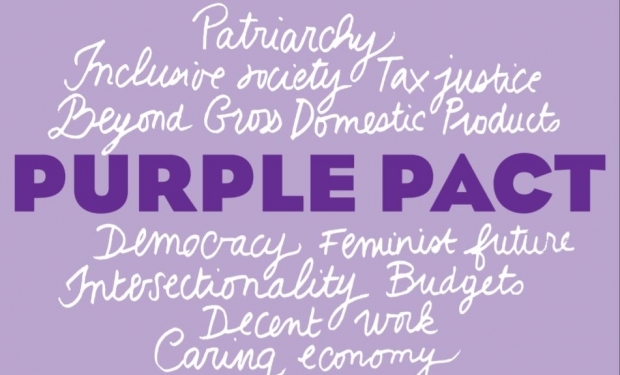We support the EWL's Purple Pact
We support the EWL's Purple Pact

The EWL’s publication “Purple Pact: A feminist approach to the economy”, the result of the EWL feminist economics working group, provides analysis and recommendations to rethink the current macro-economic system from a critical feminist perspective.
The feminist approach to the economy embodied in the EWL’s Purple Pact takes as a starting point the full participation of women in all areas of life, and equal representation of women in all their diversity, at all levels of decision-making, including economic decision-making. It aims to build an inclusive economy for the well-being of all. The focus is a universal social care system with an infrastructure that can provide social and care services for all and quality services, which are accessible and affordable. It also stresses the fact that environmental issues have always been, and are increasingly, a matter of human rights and social justice and are thus feminist issues, and an integral part of feminist economic analysis.
The Purple Pact challenges the current macro-economic model founded on unsustainable growth, at the expense of exploiting people, especially women, and the environment, which has finite natural resources. The way in which we collect tax and measure growth and productivity (i.e. through GDP) completely ignores the invaluable contributions of women’s un-paid and invisible work. This work is often performed within entrenched stereotypical roles whereby men are the bread-winners and women are the caretakers. The Purple Pact proposes, inter alia, a Care Deal for Europe, which would respond to many current challenges, primarily care as a collective need and responsibility for both women and men throughout the life cycle.
The Purple Pact is intended to stimulate debate and exchange, an invitation to a broad range of stakeholders including decision-makers at national and European level, to seriously take on board feminist economic principles in future macro-economic policies. It comes at a very timely moment as the EU adopts its five-year Strategy on Equality between women and men.
The three pillars of the Purple Economy are:
- Creating an inclusive society
- Building the care economy
- Forming a feminist future
Read an excerpt from the publication:
A FEMINIST VISION OF THE ECONOMY (p. 12):
“The great mistake of economics is thinking of the economy as separate from the society of which it is part and the environment in which it is embedded.” Prof. Kate Raworth, Oxford University
Macro-economic policy, including fiscal and monetary policy, is all too often seen as gender neutral. But economic policy choices affect women and men differently because they occupy different positions in the economy, both market (paid) and non-market (un-paid). As UN Women describes it, “budget cuts that reduce social spending may increase the demands on women’s un-paid household labour, while trade liberalisation may negatively affect women’s employment in contexts where they are overrepresented in import competing sectors such as agriculture or food crops.”4 The measure of all success, and the yardstick of current patriarchal economics, is the performance of the Gross Domestic Product (GDP).
Feminist economics, however, urge us to think beyond GDP as a goal for governments to pursue growth and look instead for new measures of well-being.5 Feminist economists are engaging in exciting new analyses and campaigns emphasising the potential role of tax and public spending as a means to redistribute power and resources to women and to ensure the outcome of equality between women and men. Moreover, there are new, powerful and interesting allies in institutions and civil society in this struggle.
Our vision of feminist economics:
- Is based on a macro-economic framework that takes full account of the contribution that women are making to the economy and the well-being of women and men at all levels, whilst introducing economic measurements and monitoring mechanisms which go beyond GDP and allow for assessments based on real economic value, i.e. un-paid work, accountability and transparency;
- Outlines concrete ways to restructure the economy, introduces policies and actions based on the fundamental values of feminism, which embrace justice, solidarity, equality, including equality of opportunities, non-discrimination and respect of diversity and the natural environment;
- Takes a new approach to labour market policies and regulations, and support structures so that they take full account of people’s lives and life-courses rather than the other way around (as currently practiced under the patriarchal system);
- As such, the feminist Purple Economy is a formidable alternative to current policies and a real challenge to the current patriarchal system.
- Purple Economy core principles of peace, justice, inclusion, equality and the promotion of well-being are already in line with the people-centred approach embedded in the vision of a feminist society. What is needed now is action.
POLICY MILESTONES TOWARDS A PURPLE PACT (p. 13):
- All measures must address the multiple and intersecting discrimination faced by women;
- Carry out gender impact assessments of macroeconomic policies;
- Ensure that the EU macro-economic framework, including post Europe2020 specifically seeks to realise gender equality;
- Close the gender pay, poverty and pension gaps by concentrating on eradicating the underlying cause;
- Implement gender budgeting /
- Invest in the Care Economy and divest in military spending;
- Eradicate all forms of male violence against women;
- Guarantee all women’s economic independence;
- Invest in decent and quality jobs that guarantee decent pay, healthy working conditions and full and equal rights;
- Ensure that the judicial system plays its full role to end all forms of exploitation of persons whilst ensuring comprehensive victims’ rights;
- Establish quality, accessible and affordable care services throughout the lifecycle.
The full publication of the Purple Pact in its original English version can be found on the European Women's Lobby website or in the attachment below.